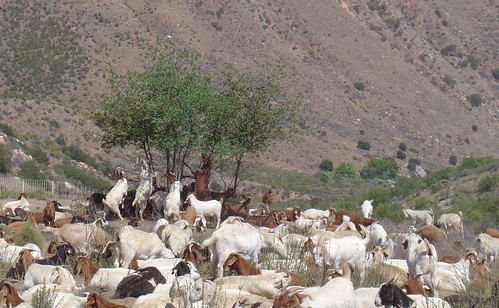
Recently, 1,400 goats reported for duty with the U.S. Forest Service. Their mission: Lend their appetites to the removal of fuels buildup on the Cleveland National Forest.
The goats were a part of a 100-acre forest-thinning project that begin in late April to clear a 300-foot community fuel break area between the San Vicente/Barona Mesa communities and the forest.
“This community fuel break was designed to help defend the communities from wildfires originating on forest land and those that originate on private lands and spread onto the forest,” said Palomar District Ranger Joan Friedlander. “To clear a fuel break normally means lots of human power and machinery, including chainsaws, hand tools and safely burning piles of brush.”
The forest considers the goat grazing project an experiment in determining the best avenue to maintain the fuel break and prevent fire hazard in San Diego County said Friedlander.
The goats were specifically tasked to reduce and slow the regrowth of vegetation, particularly chamise, a type of evergreen shrub found in California and Northern Mexico. The shrub tends to sprout up quickly after being cut, so the test is to see if the goats might be a more economical way to combat that rapid regrowth.
Several elements were used to keep the goats on task. Six border collies served as herding dogs and two Anatolian guard dogs were used to protect the goats from coyotes, mountain lions and people.
The initial project was completed in May. Goat-powered fuels reduction cost between $400-$500 per acre, nearly one-third of the cost of more labor-intensive methods of brush clearing. Project organizers also pointed out the tremendous amount of community support and interest the forest experienced due to this project.
In moving forward with this project, the forest established a plan to monitor both pre– and post-treatment plots so that the effectiveness could be evaluated over time and compared to traditional methods also used in this area.
“We will continue to evaluate other methods that will best meet our objectives of protecting and sustaining the forest and community,” Friedlander said. “But the goats could prove to be a useful resource to have in our toolkit, particularly in areas where more conventional methods may not work as well.”
No “kidding,” these goats contributed to forest health merely by being hungry.
